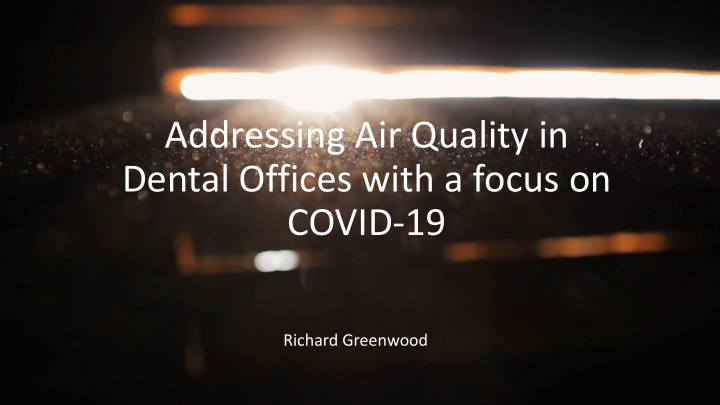



Addressing Air Quality in Dental Offices with a focus on COVID-19 Richard Greenwood
There are four disease transmission routes In the West, not enough is being done against these two: 1. Direct contact 2. Indirect contact 3. Droplet 4. Airborne Coming in contact directly Coming in contact Coming in contact with Coming in contact with airborne, with an infected person. with an infected object. droplets from an microscopical particles (i.e. handshake) (i.e. door handle after infected person. coming from an infected person. an infected person (i.e. saliva droplets (i.e. sharing a room and has interacted with it) from a sneeze) breathing the same air.)
Its not all about COVID-19 We will never go back to ‘normality’ again. But we seal ourselves up in energy efficient boxes and have growing amounts of air indoor pollution to deal with, including viruses. Spending money on an ‘ air pollution solution ’ should deal with as much of the problem as possible.
What is the problem? • Particulate matter • Viruses • Extremely small particles • Dust • Bacteria • Gases • Pollen • Mold • Dander • Fungus
AIR PURIFICATION Are filters effective on trapping the viruses? Here is a table of MERV filter model filtration efficiency, see on Coronavirus that the higher the grade, the more effective the filter is, a MERV 15 has a 68% efficiency on SARS (i.e., SARS-CoV-1), which is similar to SARS-CoV-2 (the virus that causes COVID-19). Independent studies show aerosolised viral penetration of HEPA filters. (Long et al., Biosafety 2012 & Joseph D. Wander, Air Force Research Laboratory, 2007)
Common Technologies to inactive particles in air UV Radiation, Photocatalytic Oxidation Heat Plasma Ionization One of the common downfalls of air inactivation technologies is dwell time with forced airflow. It is common practice for air inactivation to be tested over a period of time within a test chamber but if we go back to the comment about viruses:
If we are pulling a virus out of the breathing zone and processing it through clean air technology, is it acceptable for some of that virus to be distributed back into the breathing zone? For this reason, I believe that single air pass test results should be used to give virus kill rates, not chamber test results that can be confusing at the best of times.
Gases and VOC’s The most common way of dealing with gases and volatile organic compounds is to use activated carbon filters. Activated carbon works via a process called adsorption, whereby pollutant molecules in the fluid to be treated are trapped inside the pore structure of the carbon substrate.
Airflow The starting point to any clean air technology implementation should be the airflow that it creates. The objective is to pull polluted air out of the breathing zone, process the pollution and disburse clean air back into the breathing zone. Note: airflow and air exchanges are two very different things and creating the wrong airflow can cause further infection risk
Generally: The tighter the building envelope, the worse the indoor air is. Most people think that if they seal themselves indoors and turn on an air purifier, they will be safe. Clean air technology is something that should be a standard part of modern day life, we are the indoor generation. You take an average of 20,000 breaths per day and release on average 500 litres of CO2 per day CO2 is the elephant in the room and the reason that good ventilation should form a major part of your clean air strategy
• Good Ventilation • Decide what air pollutants are important for you to Recommended deal with Solutions. • Clean air technology should be chosen that is proven to deal with the pollutants concerning you. • Virus kill rates should be given on a single air pass • The right airflow is of PARAMOUNT importance.
Viruskiller™ Viruskiller™ is a clean air technology that was funded by the South Korean Government as an emergency response to the 2003 SARS outbreak (i.e., SARS-CoV-1). It was developed by a consortium on universities and Government bodies. Its main strengths are: • SINGLE AIR EXCHANGE KILL RATES The technology is able to help kill viruses in a single air pass through the unit. • AIRFLOW CONTROL Designed in partnership with the Korean Aerospace University, the units have unparalleled airflow control in just about any indoor environment. They draw contaminated air out of the breathing zone and into the unit, help to purify it in a single air pass and release safe air back into the breathing zone • PROVIDES EXTRA LAYER OF PROTECTION IN ADDITION TO PPE Although it is impossible to eliminate risk, when used in addition to PPE, Viruskiller™ can help reduce exposure
Recommend
More recommend